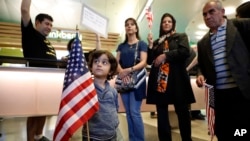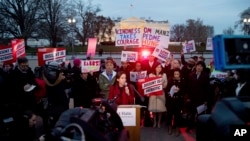The first four months of a U.S. refugee program wholly determined by the Trump administration have led to a dramatic decline in Muslim refugees coming to the United States, and a significant shift in where refugees are coming from, according to a VOA review of official data.
From Oct. 1, 2017 to Jan. 25, 2018, - the start of the first full fiscal year under President Donald Trump - 13 percent of refugees who came to the U.S. were Muslim, compared to 35 percent during the first nine months of Trump's first year in office, when the parameters of the program had been set by President Barack Obama's administration.
During this period, six predominantly Muslim countries showed the greatest decrease in the share of total arrivals: Iraqis, for example, who comprised about 10 percent of new refugees from January to September, dropped to 1 percent; Syrians went from 8 percent to less than 1 percent; and Somalis from 10 percent to 2 percent.
Iran, Sudan, and Afghanistan also saw declines.
One year, three orders
On Jan. 27, 2017, a Friday afternoon and a week into his tenure, the newly-elected President Trump issued an executive order restricting travel. With one of his first acts in office, he set in motion what would be the first of three attempts to ban travelers from some countries to the United States - including refugees.
And no program was curtailed as swiftly - and dramatically - under Trump as U.S. refugee admissions. The rationale put forward in his travel order was, in part, one of pausing the refugee program to develop more screening measures to “ensure that those approved for refugee admission do not pose a threat to the security and welfare of the United States.”
In the last year, refugee arrivals plummeted to nearly record lows, as the administration implemented the lowest ceilings for refugee admissions ever. The infrastructure of the program, in place since 1980, took hit after hit. Senior refugee staff members in Washington left their posts. The agencies that help resettle refugees slashed positions in the U.S. and abroad to cut costs, and are being required by the U.S. State Department to collectively close 50 offices around the country.
Initially, Trump framed the pause on all refugee arrivals as a temporary measure to “ensure that those approved for refugee admission do not pose a threat to the security and welfare of the United States.” But admissions never came to a full stop for very long, after lawsuits challenged the legality of Trump’s January, then March, executive orders banning refugees and some travelers.
Another order in October tightened requirements on refugees from 11 countries, with experts and officials saying the changes could add months, if not years, to the process, effectively banning them from coming into the United States.
Officials did not name the countries, but media reports identified them as the same whose nationals already undergo higher-level screening known as Security Advisory Opinions.
Few refugees from those countries have come since October.
Egypt: 0
Iran: 29
Iraq: 79
Libya: 0
Mali: 0
North Korea: 0
Somalia: 130
South Sudan: 11
Sudan: 38
Syria: 33
Yemen: 0
"The safety and security of the American people is paramount," a State Department spokesperson wrote to VOA when confronted with the numbers. The spokesperson added that additional vetting procedures announced in October, allow the U.S. "to more thoroughly and safely process applicants."
Drop in refugees recent
During the first nine months of the Trump administration, even though the volume of refugees started to decline, the religious profile remained roughly on par with recent years: from Fiscal Year 2002 through Fiscal Year 2016, which spanned the presidencies of George W. Bush and Obama, Christians accounted for about for 46% of total refugee arrivals; Muslims for 32%, and other or no religions for 22%.
Although Christian arrivals slowly inched upwards in early 2017, overall, 35 percent of the 23,699 arrivals from January to September were Muslim, 52 percent were Christian, and 12 percent were other religions - namely Buddhist and Hindu - or no religion.
It was not until the start of the new fiscal year in October, when the administration was no longer finishing out a fiscal year started by Obama and had full control over refugee decision-making that the decrease began in earnest.
The number of refugees entering the U.S. fluctuates from week to week, no matter which party is in power. Throughout the last decade, weekly arrivals were generally in the thousands. In 2017, that slowed. The last month shows the contrast: from Dec. 25, 2017, to Jan. 25, 2018, even considering a normal drop in arrivals because of the Christmas and New Year’s holidays in the U.S., 929 refugees arrived - an 81 percent decrease over the same period a year ago.
At the current arrival rate, the U.S. - long a worldwide leader in refugee resettlement - will fall short of even the halfway mark for the so-called 2018 “ceiling” of 45,000 on refugee admissions for this fiscal year.
Buddhist Bhutan surges; Muslim countries drop
Beyond the significantly lower volume of arrivals, U.S. State Department data shows that - while the administration has refuted it was denying entry to the U.S. on the basis of religion - fewer Muslims are coming as refugees. Several lawsuits allege that decisions by Trump and his cabinet discriminate on the basis of religion, and opponents of the new policies have labeled them a “Muslim ban.” The Supreme Court will consider this argument in April.
During the same period that Muslim refugee arrivals dropped, the biggest increases were from non-Muslim majority countries - and no country saw a bigger surge in its share of nationals coming to the U.S. as refugees than majority-Buddhist Bhutan, which went from 8 percent of the arrivals total, to 27 percent. The Democratic Republic of Congo, Eritrea, and Russia saw smaller increases.
The United States largely accepts refugees referred through the United Nations. There is, in theory, no prioritization for admissions based on religion, although the majority of admissions have been Christian.
With about eight months remaining in the fiscal year, and because the refugee program is so heavily controlled by the executive branch, the president could make dramatic changes. Obama’s administration pushed to resettle more Syrian refugees in the last two years of his presidency, for example, spiking arrivals as more Syrians fled the peak of Islamic State violence and civil war.
But for now the current administration’s decisions on the refugee program trend in the direction of a 2015 Trump campaign platform: a "total and complete shutdown of Muslims entering the United States."











